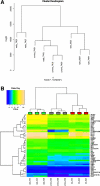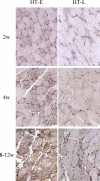Overexpression of MHC class I heavy chain protein in young skeletal muscle leads to severe myositis: implications for juvenile myositis
- PMID: 19700752
- PMCID: PMC2731122
- DOI: 10.2353/ajpath.2009.090196
Overexpression of MHC class I heavy chain protein in young skeletal muscle leads to severe myositis: implications for juvenile myositis
Abstract
Folding and transport of proteins, such as major histocompatibility complex (MHC) class I, through the endoplasmic reticulum (ER) is tightly regulated in all cells, including muscle tissue, where the specialized ER sarcoplasmic reticulum is also critical to muscle fiber function. Overexpression of MHC class I protein is a common feature of many muscle pathologies including idiopathic myositis and can induce ER stress. However, there has been no comparison of the consequences of MHC overexpression in muscle at different ages. We have adapted a transgenic model of myositis induced by overexpression of MHC class I protein in skeletal muscle to investigate the effects of this protein overload on young muscle fibers, as compared with adult tissue. We find a markedly more severe disease phenotype in young mice, with rapid onset of muscle weakness and pathology. Gene expression profiling to compare the two models indicates rapid onset of ER stress in young muscle tissue but also that gene expression of key muscle structural proteins is affected more rapidly in young mice than adults after this insult. This novel model has important implications for our understanding of muscle pathology in dermatomyositis of both adults and children.
Figures





Similar articles
-
Activation of the endoplasmic reticulum stress response in autoimmune myositis: potential role in muscle fiber damage and dysfunction.Arthritis Rheum. 2005 Jun;52(6):1824-35. doi: 10.1002/art.21103. Arthritis Rheum. 2005. PMID: 15934115
-
Myofiber stress-response in myositis: parallel investigations on patients and experimental animal models of muscle regeneration and systemic inflammation.Arthritis Res Ther. 2010;12(2):R52. doi: 10.1186/ar2963. Epub 2010 Mar 24. Arthritis Res Ther. 2010. PMID: 20334640 Free PMC article.
-
The immunoproteasomes are key to regulate myokines and MHC class I expression in idiopathic inflammatory myopathies.J Autoimmun. 2016 Dec;75:118-129. doi: 10.1016/j.jaut.2016.08.004. Epub 2016 Aug 10. J Autoimmun. 2016. PMID: 27522114
-
Role of major histocompatibility complex class I molecules in autoimmune myositis.Curr Opin Rheumatol. 2005 Nov;17(6):725-30. doi: 10.1097/01.bor.0000179947.58271.9a. Curr Opin Rheumatol. 2005. PMID: 16224250 Review.
-
Idiopathic inflammatory myopathies: from immunopathogenesis to new therapeutic targets.Int J Rheum Dis. 2015 Nov;18(8):818-25. doi: 10.1111/1756-185X.12736. Epub 2015 Sep 19. Int J Rheum Dis. 2015. PMID: 26385431 Review.
Cited by
-
PERK regulates skeletal muscle mass and contractile function in adult mice.FASEB J. 2019 Feb;33(2):1946-1962. doi: 10.1096/fj.201800683RR. Epub 2018 Sep 11. FASEB J. 2019. PMID: 30204503 Free PMC article.
-
Regulation of Cytokine Production by the Unfolded Protein Response; Implications for Infection and Autoimmunity.Front Immunol. 2018 Mar 5;9:422. doi: 10.3389/fimmu.2018.00422. eCollection 2018. Front Immunol. 2018. PMID: 29556237 Free PMC article. Review.
-
Differential expression of miRNAs associated with pectoral myopathies in young broilers: insights from a comparative transcriptome analysis.BMC Genomics. 2024 Jan 23;25(1):104. doi: 10.1186/s12864-024-09983-9. BMC Genomics. 2024. PMID: 38262955 Free PMC article.
-
Role of non-immune mechanisms of muscle damage in idiopathic inflammatory myopathies.Arthritis Res Ther. 2012 Apr 27;14(2):209. doi: 10.1186/ar3791. Arthritis Res Ther. 2012. PMID: 22546362 Free PMC article. Review.
-
The juvenile idiopathic inflammatory myopathies: pathogenesis, clinical and autoantibody phenotypes, and outcomes.J Intern Med. 2016 Jul;280(1):24-38. doi: 10.1111/joim.12444. Epub 2016 Mar 30. J Intern Med. 2016. PMID: 27028907 Free PMC article. Review.
References
-
- Rider LG, Miller FW. Classification and treatment of the juvenile idiopathic inflammatory myopathies. Rheum Dis Clin North Am. 1997;23:619–655. - PubMed
-
- Wedderburn LR, Li CK. Paediatric idiopathic inflammatory muscle disease. Best Pract Res Clin Rheumatol. 2004;18:345–358. - PubMed
-
- Huber AM, Lang B, LeBlanc CM, Birdi N, Bolaria RK, Malleson P, MacNeil I, Momy JA, Avery G, Feldman BM. Medium- and long-term functional outcomes in a multicenter cohort of children with juvenile dermatomyositis. Arthritis Rheum. 2000;43:541–549. - PubMed
-
- McCann LJ, Juggins AD, Maillard SM, Wedderburn LR, Davidson JE, Murray KJ, Pilkington CA. The Juvenile Dermatomyositis National Registry and Repository (UK and Ireland)–clinical characteristics of children recruited within the first 5 years. Rheumatology. 2006;45:1255–1260. - PubMed
Publication types
MeSH terms
Substances
Grants and funding
LinkOut - more resources
Full Text Sources
Medical
Molecular Biology Databases
Research Materials

